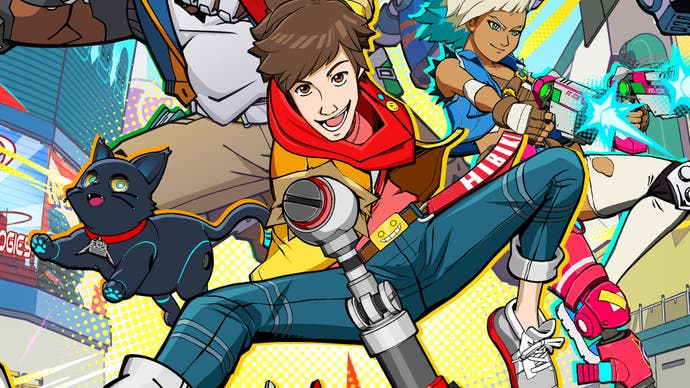Hi-Fi Rush tech review: a visual treat indebted to comics and TV cartoons
DF's analysis of the Series X/S and PC versions.
Hi-Fi Rush is superb. Announced at Microsoft's Developer_Direct showcase last week and released immediately thereafter, the game is a wildly creative effort from developer Tango Gameworks. There are elements of action, platformer, rhythm and side-scroller games, all held together by an incredible sense of style and bold visual choices.
This is a wild, courageous game that succeeds on just about every level - and it's an eye-popping visual treat as well. It's also the first major first-party Microsoft title in over a year, ending a prolonged drought for exclusive Xbox software. Today, we'll be taking a look at Hi-Fi Rush's daring flair and beat-matching brawling action, and try to get a sense of what makes this game tick.
Let's explain how the game works, before we get into the technical nuance. It's really a thrill ride from the get-go, a snappy character action game where you dodge, attack, parry, jump, grapple, and unleash a host of special abilities, all actions beautifully animated and super responsive. On a basic level, it's not so different from something like Devil May Cry, but the key is that most in-game actions work better when timed to match the background beat. For example, attacks get a bonus when they're done to the beat, which is conveyed through the idle animations, game environment and UI as well as the music. Similarly, enemies moves correspond to musical moments, helping you anticipate their actions. The system never feels overwhelming and quickly becomes natural.
Hi-Fi Rush looks special too. It essentially mimicks the look of flat, 2D animation within 3D game content, with cel-shaded characters with bold, uneven outlines and dramatic colour-rich designs that are reminiscent of TV cartoons. Animation is critical too, with character movements updating at 15fps to give motion a staccato, hand-drawn quality. For production reasons, key animations in 2D television are often animated "on twos", or between 12fps and 15fps, so this proves to be a great match. In gameplay though, animation is at full rate to aid playability.
There's a sort of animated expressiveness to the way that characters moved that I love; everything seems based around a set of dramatic key poses, just like traditional 2D, which keeps the game in line with animation conventions. The only real giveaway during cutscenes is that characters maintain perspective-correct detail and proportions, which wouldn't be typical of hand-animated 2D. Camera animation also updates at full-rate, which tends to look good, eg during scene pans, but can look a bit awkward in the few moments featuring swooping, rotating camera movement.
None of this would work well with a traditional materials pipeline and lighting model, so Hi-Fi Rush makes universal use of cel-shading. The black-outlined characters are generally lit with just two bands of lighting, while environments show a bit more variability. Generally though, texture detail is kept to an absolute minimum. That makes Hi-Fi Rush distinct from most other cel-shaded games, as titles like Breath of the Wild, Persona 5 and even Jet Set Radio still use more realistic rendering for environments and background detail.
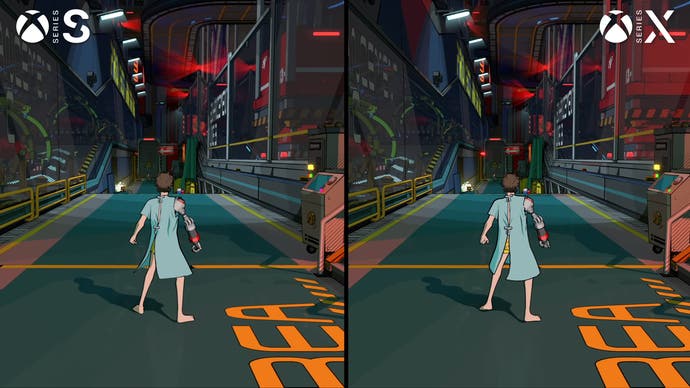
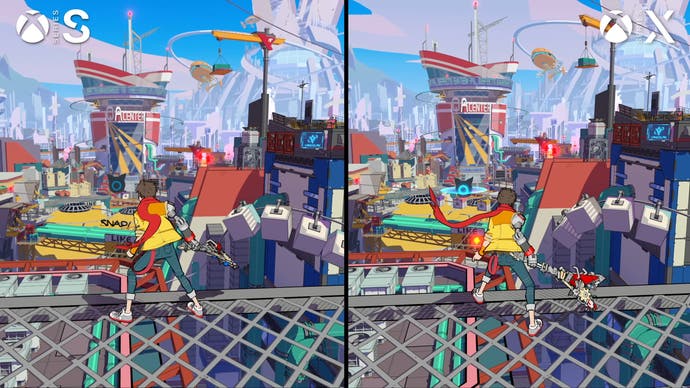
Environments in general showcase some of the game's more inspired artistic choices. Real-time lighting details are masked into halftone comic-book style patterns, which is prominently visible in bloom and in screen-space reflections. Ambient occlusion is rendered as cross-hatched patterns. Real-time shadows have a 'gloopy' rounded look and feature animated transitions between different shadow cascade levels. The outline shader is active across environmental geometry as well, producing beautiful thick black silhouettes. Backgrounds are often portrayed with bold 2D art instead of geometry. And there's so much ambient animation thrumming through areas at any given time, again all in sync with the beat.
Hi-Fi Rush has fairly simple model detail and complexity within those environments to keep them looking consistent and easily navigable, but it fits well within the game's style. My only quibble here is that most of the levels have a sort of industrial character to them, and blend together a bit - especially in the middle half of the game, despite more evocative levels at the start and end.
If any of Hi-Fi Rush's visual elements didn't work, the whole aesthetic of the game would be fundamentally compromised. This isn't like a typical 3D game where you can lean on complex lighting and a detail-packed world to overcome art inconsistencies. Tango Gameworks made a lot of bold choices in the basic construction of this title - and their bravery has been rewarded with an absolutely stunning game.
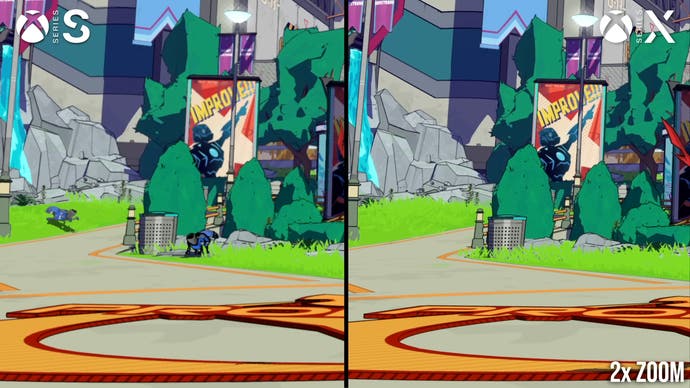
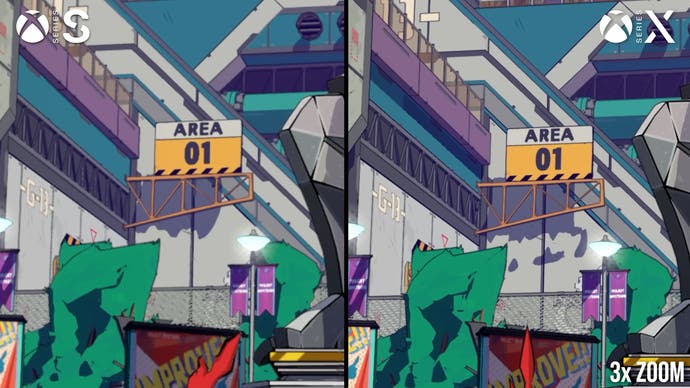
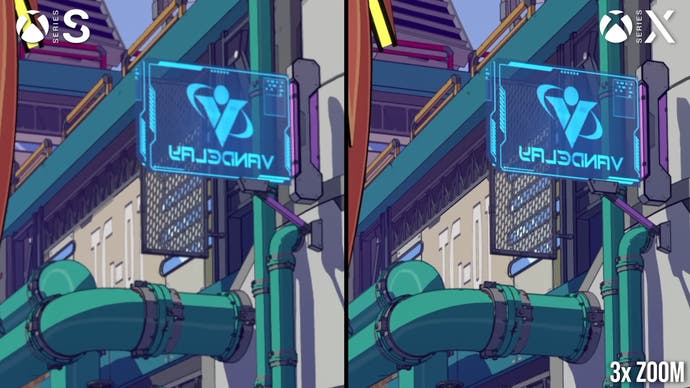
All the careful visual design in the world wouldn't give the game a proper hand-drawn look if Hi-Fi Rush looked like a jagged mess, and here the game impresses as well. Image quality is basically impeccable on Series X, with a super sharp, super clean 4K presentation throughout, while Series S looks softer but still excellent at a static 1440p. This is pretty much the best-case scenario for a console release, and it's reflected in stronger than usual image quality on both machines. There are a few subtle settings tweaks on Series S too, with lesser shadow quality at range and lower foliage density, but other visual settings appear closely matched.
Both consoles target 60fps and achieve this consistently, with no frame-rate dips at all on Series X and only an occasional 16.7ms frame drop on Series S that most players are unlikely to notice. Combined with the game's subtle but high-quality motion blur, it feels very smooth and responsive on both machines.
The game also runs brilliantly on PC, avoiding the shader compilation stutter epidemic that has infected many recent Unreal Engine 4 releases thanks to the use of a precompilation step on boot that seems to work well. We only spotted one potential piece of stutter in the first 30 minutes while running on a Core i9 12900K and RTX 4090 system, and this wasn't particularly severe at 50ms.
PC also has the potential to boost image quality considerably over consoles, with options for Unreal's Temporal Super Resolution, XeSS, DLSS and FSR 1. All of the temporal upsampling options are capable of constructing more image detail than the default TAA at native res, but XeSS and DLSS also exhibit fewer issues with disocclusion than the TAA. Other PC staples like ultrawide support and running at unlocked frame-rates are supported, although there's no field of view adjustment at present. The game seems to run well, and hitting a consistent 60 or 120fps should be possible on many machines given the wealth of upscaling options and generally reasonable system requirements.
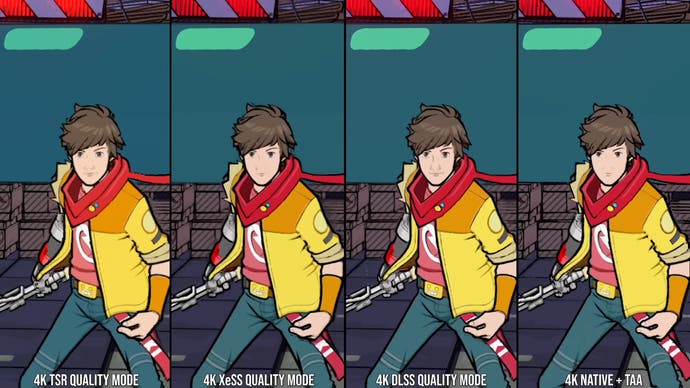
I could spend all day discussing Hi-Fi Rush - it's just that good. The game oozes style, and has clearly been created with impeccable craft and attention to detail. Its moderate run-time, about 11 hours for me, is replete with high-quality cutscenes, bespoke gameplay segments, comic book level transition sequences and proper 2D animated cutscenes that pay homage to Hi-Fi Rush's inspirations. I can't think of any other recent titles that nail a 2D animation look so thoroughly. It impresses in particular because this is a fully-3D title in both gameplay and graphics, so it can't rely on a fixed-perspective camera setup to hide its 3D elements.
Everything else that I don't have time to go into detail on today - the writing, character designs, particle effects, music, and user interface - is all top-notch stuff. This is a polished new game with novel gameplay concepts and interesting art that nails everything out-of-the-gate - you couldn't really ask for more. It almost feels like a missing member of the 'Capcom 5', an experimental, stylish game that breaks conventions to achieve something special. It definitely has a certain sixth-gen console sensibility, reminiscent of an age when unusual concepts were more often greenlit, particularly from Japanese studios.
To drop the game out of the blue on Xbox and PC was definitely a risky decision, but if anything it just adds to the aforementioned qualities. And there aren't any significant bugs or performance woes that I noticed across any platforms which is its own accomplishment. Most players will probably tackle this one on Game Pass, but I do think it deserves a full disc release at some point - especially given the licensed music it uses, which could limit its digital shelf-life.
As far as I'm concerned, this is an early contender for game of the year and undoubtedly one of the most attractive games we'll see in 2023. Hi-Fi Rush is an absolute blast - and everyone should give it a shot.
